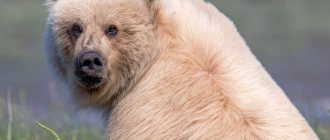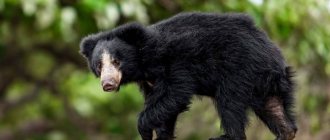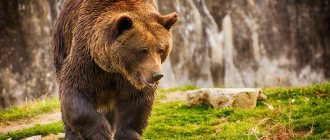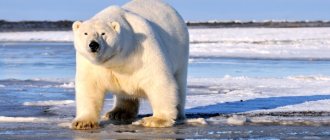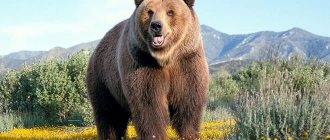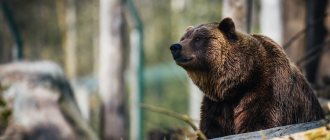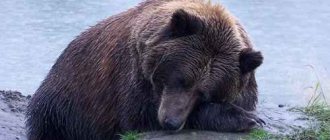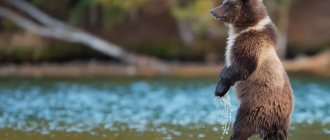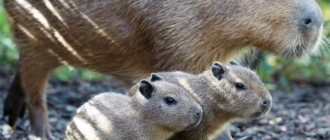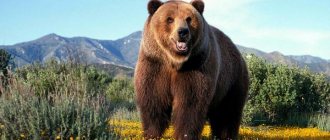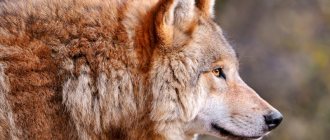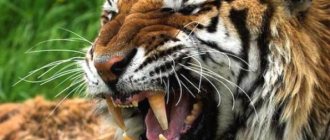The population of bears on our planet has a great variety of species and subspecies. These animals live on almost all continents. One of the species, the brown bear, also has several subspecies that have survived to this day: these are the Siberian brown bear, the Kodiak bear and the American grizzly bear.
Kodiaks represent a group of predatory mammals and are members of the bear family.
Kodiak is a bear that lives on one single island, Kodiak.
Research by scientists has shown that, as a separate subspecies of brown bear, the Kodiak evolved about 10 - 12 thousand years ago. Today there are about 3,000 individuals of this brown subspecies on the planet.
Origin of the species and description
Photo: Kodiak
Kodiak is a fairly large mammal of the order of carnivores, the bear family, the genus of bears. It is a subspecies of brown bears, so it shares many similarities with its cousins. For a long time, scientists thought that the Kodiak's closest relative was the grizzly bear. However, after conducting a molecular study, it turned out that the Kodiaks are more closely related to the Kamchatka brown bear, the largest bear in Eurasia.
This allowed us to think that the ancestors of the Kodiaks came to the North American island from the Far East, like the indigenous peoples. The bears came to this island when the island was connected by an isthmus to the mainland. However, over time, the isthmus was flooded, and the bears remained on the island part.
Video: Kodiak
Habitat: the islands of the Kodiak archipelago and Kodiak Island itself, located in the southwest of Alaska. The name of this subspecies "Kodiak" probably comes from the name of the island where it lives and where scientists first discovered this subspecies. The brown bear arrived on the islands of the Kodiak archipelago relatively long ago. However, it only began to develop into a separate subspecies 12,000 years ago. In the course of evolution, under the influence of various factors, this bear reached such an impressive size, second in size only to the polar bear.
Factors that influenced the size of the bear:
- absence of natural enemies
- easy access to plenty of food
These animals are similar in size to the already extinct short-faced bear. Scientists found a gigantic specimen on the island, immobilized it and weighed it. The weight did not reach 800 kg. Then, a few years later, people who live nearby said that the animal not only did not die, but also increased in size.
Never-before-seen monster
For the first time, Oleg Kuvaev, a professional geologist turned writer, spoke about a giant bear supposedly living in the valleys of the Anadyr Highlands. At the same time, Kuvaev referred to the stories of geologists and Chukchi reindeer herders. According to them, this rare beast is so large and ferocious that deer and people flee only after seeing its tracks. Kuvaev correlated the stories and information of the Canadian writer Farley Mowat, who heard legends about this bear, which they called “akla,” from the Eskimos. The brown monster is twice as tall as a polar bear and leaves marks three times the size of a human hand.
Alaskan bear paw
Kuvaev suggested looking for the Chukchi shark, which was either a miraculously preserved ancient cave bear, or some independent species, in the vicinity of Lake Elgygytgyn, one of the most inaccessible places in the region. So far, not a single bear resembling a shark has been found there. And no bear tracks of abnormal size were observed.
Appearance and features
Photo: Kodiak Bear
Kodiak surpasses all its brothers in size. The only competition it has is the polar bear, which is the largest animal of the family.
- body length – up to 3 meters;
- height at withers – up to 160 centimeters;
- claws - up to 15 centimeters.
Males are approximately 2 times larger than females. The average weight of males is 500 kilograms. Females reach a weight of approximately 250 kilograms. The maximum weight of bears is observed before hibernation. From the age of six he no longer grows and becomes fully adult. Scientists know about a specimen weighing 780 kilograms, which, according to local residents, has become even larger.
The large muzzle immediately attracts attention. The eyes are set wide apart for better vision. Their color is brown. The head is always lighter than the rest of the body. This is how it differs from its relative, the grizzly bear. The body type is quite typical for all brown bears. He has a compact, muscular body with long, powerful limbs and a massive head. The back sole of the paws has very rough skin, which allows it to easily tolerate cold and moisture. The tail is short and has no practical function.
This bear has quite powerful jaws with sharp teeth that can easily bite not only any plant, but also any bones. The claws of this bear have an unusual feature - they are retractable, up to 15 centimeters long and very sharp. An excellent sense of smell and excellent hearing compensate for poor eyesight, making it a very dangerous predator.
The Kodiak's coat is of medium length, but thick. Fur comes in a variety of shades of brown, from beige to dark. The most common color is dark brown, although in nature there are red-colored individuals.
For the first two years of life, the cubs have a ring of white fur around their necks. As you get older, it disappears. An interesting feature: the bears of the northern part of the island have darker fur compared to the inhabitants of the south. The average life expectancy reaches 27 years for males and 34 years for females. However, only 10% of all cubs born will reach this age, because this species has a fairly high mortality rate.
Polar bear
Third place is the polar bear, which is often called white, northern or sea, as well as oshkuy.
Dimensions and weight
This species originates from the brown bear. Scientists suggest that it appeared on Earth about 100 thousand years ago. The length of some specimens can reach 3 m and weight up to 800 kilograms. To be fair, it should be noted that such individuals are extremely rare in nature. Most often, researchers come across much smaller representatives of this species: the average body length of a male is about 2-2.5 m, and its weight is up to half a ton. Females are about one and a half times smaller.
Despite all the similarities with its ancestor, the oshkuy has a flat head with small ears on an elongated neck. The color of its coat can be either bright white or yellow - it is often faded by the sun. It is worth knowing that during ultraviolet photography, the animal’s fur coat appears dark - this is possible due to the special structure of the hairs. But the bear’s skin is completely black, although it is very difficult to notice.
Where does it live?
You can meet the beast in the northern hemisphere. Its main food is sea animals, among which we can recall seals, walruses, bearded seals, and so on. Oshkuy catches them most often from behind cover, stunning them with a powerful blow to the head. However, it can hunt in other ways. Let's say one thing: finding prey at -60°C is very difficult, but the polar bear copes with this task brilliantly. True, not always.
In our country, this species of bear is listed in the Red Book, since it reproduces slowly, and young animals often die due to other predators. There are no more than seven thousand individuals on the territory of our country; about 200 animals are shot by poachers every year.
Polar bears are excellent swimmers. Scientists recorded a case where a female swam about 700 km in icy water. This record was officially registered, as there was evidence - a GPS tracker was attached to the animal’s fur.
Where does the Kodiak live?
Photo: Giant Kodiak bear
Kodiak, as the name suggests, lives only on Kodiak Island and the adjacent islands of the Kodiak archipelago. It is located southwest of Alaska. This bear cannot be found anywhere else on the planet. Based on the fact that Alaska belongs to the United States of America, we can conclude that the bear is a native inhabitant of America. However, scientists have found that the homeland of these bears is the Far East, and their closest relative is the Kamchatka brown bear.
Since the territory is limited, the range of each bear is much smaller in size than, for example, a grizzly bear. An interesting fact, but when meeting, Kodiaks do not fight for territory. On the contrary, during salmon spawning, Alaskan bears flock to ponds to fish. The bear prefers to settle near food sources. And it changes territory only when there is not enough food for it due to the season, but only within its range.
Females are more attached to their mother and try not to go far from her, even as they mature. Males, on the contrary, run away from their previous place of residence when they reach the age of 3 years. The Kodiak prefers to spend the winter in the caves it has found. If he doesn’t find it, the bear makes a den for himself, lining it with dry leaves and grass.
What does a Kodiak eat?
Photo: Kodiak brown bear
Kodiak, like other bears, is primarily an omnivore. It can eat both plant and animal foods. These bears are excellent hunters, as their sense of smell is 4 times greater than that of a dog. They can hunt deer and mountain goats, but not all bears do this.
In spring, the bear's diet consists of carrion, young grass and algae. After hibernation, the bear needs to restore its strength, because its further survival directly depends on it. Since the habitat of this bear is in close proximity to the Pacific Ocean, the basis of the diet from May to September is fish, mainly different types of salmon. Bears go to shallow reservoirs, river mouths and wait for fish. They can catch fish from the water and grab them in flight when the fish overcomes rapids.
In autumn, their diet is replenished with mushrooms and nuts. Bears must store up a reserve of fat before hibernation. After all, they will have their next meal only 5 months after they hibernate. This problem is especially acute for females, because they will also have to feed their cubs all winter.
Kodiaks may change their place of residence slightly throughout the year in search of products that may be in limited quantities. This allows you to diversify your diet and take advantage of it. The abundance of food and its availability makes it possible for these bears to reach such sizes.
Nutrition
The diet of bears is extremely varied. They are characterized by both animal and plant foods. The choice of food depends on the time of year. Animals such as goats and deer can become victims of the Kodiak. But only adult bears hunt.
In spring, animals prefer to eat various carrion and vegetation. At the end of hibernation, they actively feed to restore strength. Since Kodiaks live near the Pacific Ocean, they quite often eat various fish. To do this, they approach small bodies of water and wait for fish. They can also catch it from the water.
In autumn, animals prefer nuts and mushrooms. This food helps them stock up on nutrients during hibernation. Females feed especially heavily, as they are forced to feed their offspring during hibernation.
Features of character and lifestyle
Photo: Kodiak
This subspecies of bears leads a lifestyle similar to the life of its other brothers. They lead a solitary life. The only exceptions are couples during the mating season and females with cubs. Each bear has its own habitat, although it is significantly smaller than, for example, a grizzly bear. The territory of males is approximately 2 times larger than that of females. The bear declares its territory by marking it. It can wallow in the mud, mark with urine, or rub against trees, leaving its scent. This lets other bears know that the area is occupied. Although, when two bears meet in the same territory, they will not fight for it, but will disperse peacefully.
The Kodiak leads a predominantly diurnal lifestyle, but can also go out to feed at night. It migrates only within its habitat in search of seasonal food and is not capable of long-term migration. With the onset of the first cold weather, bears hibernate and remain in it until spring. It is very important for bears to stock up on fat reserves in order to survive until next spring. Although in their territory of residence, full of food products, this will not be difficult to do. It usually winters in found caves, but can also settle in a den.
They treat people with curiosity. However, if they sense danger, they may attack. When communicating with them, you must try not to let them get close, because even adolescents of this species are significantly superior to humans in strength and size. If the bear does come closer, you should try to scare it off by shouting, do not try to run away and calmly leave, without showing any intention to attack.
Can it attack a person?
In general, Kodiak bears traditionally avoid any encounters with people, which is why attacks on humans are extremely rare. For example, during the entire 20th century, only two such cases were recorded that led to the death of people. The incidents occurred in 1921 and 1999. Moreover, in both cases, hunters who tried to catch and kill a Kodiak bear were injured. The hunters failed to do this with the first shot; they only wounded the animals. As a result, the furious animals tore the hunters to pieces. Therefore, in these cases it cannot be said that the attack was caused by animal aggression; the blame rather lies with the hunters themselves.
Social structure and reproduction
Photo: Kodiak Bear
The mating season for Kodiaks begins in mid-May and until the end of June. It is at this time that the largest amount of food is observed. This type of bear has low competition for females, because each male finds only one female to mate with. An established couple can stay together from a couple of days to several weeks.
Kodiak females, like some other species of bears, exhibit a delay in implantation of the embryo into the uterus. So the egg with the baby begins to develop only at the end of November. The birth of babies occurs in January or February; in any case, at this time the female is in hibernation. Approximately 2-3 cubs are born in one litter. For the entire period until spring, they will feed only on their mother’s milk. Sometimes, if a female abandons her cubs, another she-bear may take them in.
Bear cubs have a fairly high mortality rate. About 50% of cubs do not even survive to 2 years. Those who were able to survive remain with their mother for up to 3 years, the mother teaches them to hunt and protects them from older individuals. At 3 years old they become completely independent and begin their own lives. Females reach puberty at 4 years, males at 5 years.
A female bear can only give birth every 4 years, when she finishes caring for the previous offspring. Due to low birth rates and high mortality rates, the population of these bears is recovering very slowly.
Natural enemies of the Kodiak
Photo: Kodiak
Kodiaks have no natural enemies left in their habitat. However, their population is threatened by such dangers as parasites, mass diseases, hunters and poachers. Due to the fact that their population density is much higher than that of other bears, mass diseases develop in them quite quickly.
The blight could kill more than a hundred bears, devastating their small population. The main danger for children remains adult bears. Often they try to attack them. The mother fiercely protects her cubs, but females are often much smaller in size than adult bears.
The most vulnerable group of Kodiaks are teenagers. They are no longer under the protection of the female bear, but have not yet gained the necessary mass for independent protection from adult individuals. So during this period, young bears try not to attract attention and, if possible, avoid meeting other bears.
Human activity causes great damage to the bear population. Even harmless tourists can later cause the death of an Alaskan bear. They can scare the bear away from its usual feeding place, which is why it will not be able to store fat and survive hibernation. Poaching nearly wiped out this species at the beginning of the 20th century, which could have been another irreparable loss for humanity.
